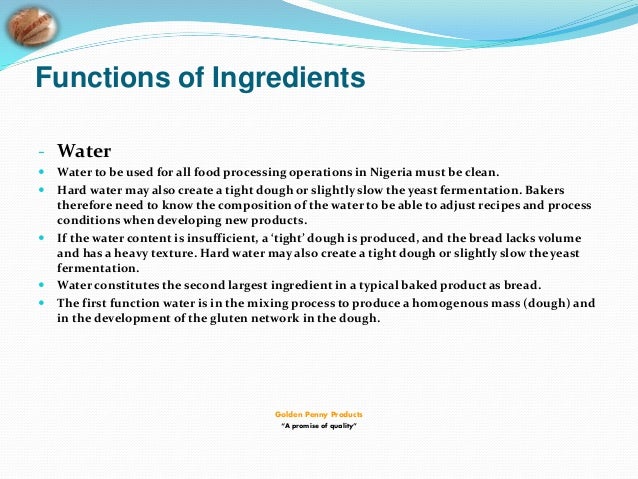
Water plays a crucial role in baking including color and flavor formation enzyme and Schiraldi and Fessas 2012. 1Laboratory of Food Chemistry and Biochemistry and Leuven Food Science and Nutrition Research Centre LFoRCeKU Leuven.

You can use water directly from your tap.
Role of water in bread making. The role of water is related to the uniformity and consistency of the dough the setting of the temperature of it and finally the texture and bread volume. This means that water as sprayed steam sit on the chin of dough and acts as a heat carrier The Role of Water in Baking Bread. Water levels in rye bread doughs.
Pre-hydration of flour wheat and other grains in the manufacture of bread and fermented products. Water in brews and sponges. Water and dough development.
The effects of dough ingredients on water levels in bread doughs. Other factors affecting the level of water added to doughs. Dough and water temperatures.
Water is perhaps the most overlooked ingredient in the bread making process. By hydrating the starch and proteins and dissolving the yeast and salt granules water is a key factor in the basic formation of dough. Furthermore water creates a humid environment appropriate to the development of enzymatic activity and bread fermentation.
Bread dough and bread are dispersed systems where several aqueous phases coexist and exchange water from one to another. These water displacements are responsible for many chemical and physical properties of the single aqueous phases and the whole system. Water plays a crucial role in baking including color and flavor formation enzyme and Schiraldi and Fessas 2012.
It has been demonstrated that addition dietary fiber to bread increased bread. In this review roles of water and water migration on bread staling are summarized and discussed. NaCl addition on wheat bread making performance volume baking loss crumb firmness crumb.
Water allows your bread dough to develop the right consistency. It also gives the yeast in the dough the perfect environment in which to ferment and reproduce. The role of water goes even further.
When pouring in yeast from a packet as well as sugar and salt water lets these ingredients disperse across the bread dough. Water serves as a solvent and dispersing agent for salt sugar and yeast. Water is necessary for yeast fermentation and reproduction.
Softer doughs will ferment more quickly than dry doughs. Water is responsible for the consistency of bread dough. The temperature of water can be varied in order to obtain dough of the correct temperature.
Bread Mix Water and a Bread Making machine. What role does yeast play in making of bread. It makes bread rise and expand.
It also helps to keep the bread flat and taste like cherries. Water plays a key role all through the breadmaking process starting with mixing and ending with contributions to end product eating and keeping quality. These pivotal roles are described in Chapter 20.
Critical reference to dough rheology its control and contribution to final product quality is. Any water which is fit to drink can be used for bread making. Water binds together the insoluble proteins of flour which form gluten.
Too much water may spoil the binding of all ingredients. Milk in Bread Baking. In the dough stage milk increases water absorption.
Consequently dough made with milk should come softer from the mixer than dough made with water. Other aspects of milk in yeast doughs include. Dough may be mixed more intensively.
Milk yields dough with a higher pH compared to water dough and the fermentation will be. As it turns out the water source might only matter in extreme circumstances or when working with starters. In bread making the most important factor in monitoring water quality is the chemicals used to purify it.
Chlorine levels are the most important player here as it is able to slow or end fermentation. Water is recommended for rehydrating or dissolving yeast. You can use water directly from your tap.
It is best to use water of medium hardness 50-100ppm for breadmaking. Too hard or too soft water as well as water high in fluoride or chlorine will result in short stubby loaves. Study of the role of bran water binding and the steric hindrance by bran in straight dough bread making.
Hemdane S1 Langenaeken NA1 Jacobs PJ1 Verspreet J1 Delcour JA1 Courtin CM2. 1Laboratory of Food Chemistry and Biochemistry and Leuven Food Science and Nutrition Research Centre LFoRCeKU Leuven. This gives the temperature at which the water known as process water in commercial bakeries needs to be for that particular recipe when added to the flour.
The main thing to remember is that the temperature of the water or milk added to a bread dough is very important. Naturally each ingredient the preferment the flour the water and the ambient environment has a temperature and while most of these are out of our control we can adjust the water temperature. Adjusting it enables us to change the FDT of the.